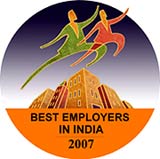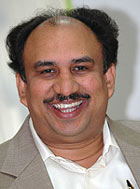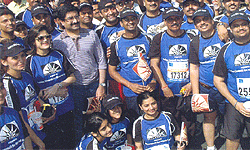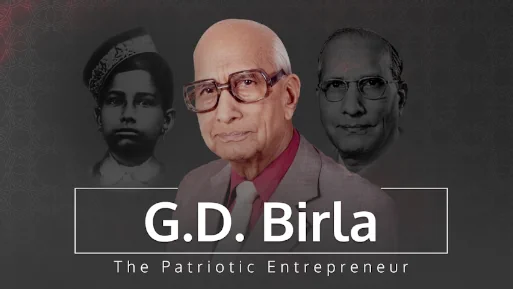India's Best Employer 2007: Aditya Birla Group
01 October, 2008 | hrm
ShareAnanya Mukherjee
HRM
Issue 8.2
The Aditya Birla Group is a US$ 28 billion conglomerate in the League of Fortune 500. With operations in 20 countries, across 17 businesses and a workforce of 100,000 employees, how does the Group's HR department function consistently across borders? HRM's Ananya Mukherjee discovers the secret formula to this success story.
No matter how big or small your corporate empire is, it is not easy being an 'employer of choice', especially when your business is vast, diverse and spread over several time zones. Being a conglomerate, consistently applying common practices is tough, agrees Dr. Santrupt B Misra, director, HR &IT, Aditya Birla Management Corporation — the strategic apex of Aditya Birla Group. "The location of the bulk of our people in remote areas makes it tougher," he admits.
Yet, Aditya Birla Group has been recognised for
 consistency in its people practices and declared India's Best Employer in 2007 by Hewitt Associates. The main factors that Misra believes contributed to the Group's status as best employer include "the capability to leverage talent from a wide variety — e.g. from basic to rarest of rare, from own nurtured to acquired, from domestic to international/expatriate etc; the ability to address multiple employee needs in multiple situations in a comprehensive manner — e.g. from basic needs to security, education to development needs through multiple roles/task forces; well-designed plans to reach beyond the employee to their family through employee wellness programmes; reaching out with a network of schools to the families and the community around our plants; and multiple rewards and recognition process which include small recognitions like a smiley, employee of the month and the group-wide team and individual recognitions at the Chairman's level".
consistency in its people practices and declared India's Best Employer in 2007 by Hewitt Associates. The main factors that Misra believes contributed to the Group's status as best employer include "the capability to leverage talent from a wide variety — e.g. from basic to rarest of rare, from own nurtured to acquired, from domestic to international/expatriate etc; the ability to address multiple employee needs in multiple situations in a comprehensive manner — e.g. from basic needs to security, education to development needs through multiple roles/task forces; well-designed plans to reach beyond the employee to their family through employee wellness programmes; reaching out with a network of schools to the families and the community around our plants; and multiple rewards and recognition process which include small recognitions like a smiley, employee of the month and the group-wide team and individual recognitions at the Chairman's level".
What works best in Aditya Birla Group
Having an aggressive growth plan with structured people processes that provide flexibility for individual creativity has worked well for the Group, says Misra. "The organisation's strength has been its high quality talent and strong financials, which help to further build on their leadership positions; and the freedom for employees to charter their career path of choice across businesses spread across 20 countries in six continents where Aditya Birla Group has a presence."
The Aditya Birla Group also has a structured set of processes to support this. Its internal recruitment scheme, global mobility policy, talent management, job analysis and evaluation and opportunity for continuous learning have proven to be sound employee propositions. Beyond that, there is a strong emphasis on employee engagement, says Misra. The Group, he shares, regularly monitors employee engagement at all levels across the Group through the biennial organisation health study (OHS), which is led by the chairman. Subsequent actions are taken based on the outcome of the study, which gives employees a unique opportunity to anonymously and frankly express their opinions on a range of issues. The last OHS was conducted across the group in 2006, in which almost 15,600 employees participated. "The employees also have the perception that Aditya Birla Group continuously works towards enhancing individual competence and keeping them employable," Misra says. This was reflected in the last OHS, in which 67 per cent of respondents stated that they would recommend Aditya Birla Group to others looking for a meaningful career. 69 per cent stated they would like to continue work in the same business even two years from the time of the survey, and 71 per cent felt that they received adequate training to do their job well.
Key HR initiatives
 One of Aditya Birla Group's approaches to building their employer of choice brand has been through considering employees as a Group resource, Misra emphasises. "This helps to c;reate a feeling of bonding and oneness amongst them, while maintaining continuity of service across the Group. This also reinforces the multiple options available to employees across geographical locations and businesses, from which they can choose (based on personal choice, risk appetite, career stage, etc) their career development," he says. "A common set of values and a code of conduct are applicable to all management cadre employees across the group. This helps to clearly articulate the expected standard of professional behaviour from each employee, irrespective of geographies and business."
One of Aditya Birla Group's approaches to building their employer of choice brand has been through considering employees as a Group resource, Misra emphasises. "This helps to c;reate a feeling of bonding and oneness amongst them, while maintaining continuity of service across the Group. This also reinforces the multiple options available to employees across geographical locations and businesses, from which they can choose (based on personal choice, risk appetite, career stage, etc) their career development," he says. "A common set of values and a code of conduct are applicable to all management cadre employees across the group. This helps to clearly articulate the expected standard of professional behaviour from each employee, irrespective of geographies and business."
Recognising human endeavours and applauding employees across all units of the Group — including the joint venture companies through The Aditya Birla Awards for Outstanding Achievement — has also been a key engagement factor, says Misra. "This process was launched in 1996, and today has become an institutionalised form of recognising excellence across the Group. During the awards, a number of Group-wide competitions are conducted. Over the years, competitions like Vision 2015, Oh! Not So Smart, Aditya Birla Group value leaders poll, etc, have been conducted. These competitions are open to all employees of the group."
Creating a common portal in which employees can access information about the Group has also been useful. Aditya Birla Group has a single portal which provides various job opportunities across levels, businesses and geographical locations of the Group. The company also celebrates its achievements, for example the title of Best Employer in India and Asia. "This was celebrated throughout the Group by sending a commemorative pen (Cross) with the Chairman' s signature and the inscription 'A Moment to cherish - 2007' to the 20,000 management cadre employees of the Group. Along with the pen, a personalised message from the Chairman was also sent to every employee. Celebrations were carried out across all Group locations with a specially composed song 'We are the Best' and an audio-visual presentation."
Other HR schemes
 Aditya Birla Group classifies its various HR initiatives over the last five years into the following categories: recruitment and staffing, nurturing talent, performance management, opportunities for learning, rewards and recognition, Group-wide people process, quality of life beyond work, and integrating effectively.
Aditya Birla Group classifies its various HR initiatives over the last five years into the following categories: recruitment and staffing, nurturing talent, performance management, opportunities for learning, rewards and recognition, Group-wide people process, quality of life beyond work, and integrating effectively.
With regards to recruitment and staffing, Misra says: "When hiring in markets and varied sectors across the globe, we grapple with a variety of local market realities. Appreciating ground realities in various geographies includes complying with local laws, understanding business practices and customs, as well as respecting social norms. In the last two years, over 3,400 new hires (not including acquisitions) have joined our businesses in the management cadre."
The Group has a multi-pronged recruitment approach, Misra explains. Policies are common at the Group level, while execution is tailored to meet the needs of individual businesses. To ensure a fit with Group values, senior level potential recruits meet with the Chairman before an offer of employment is made. Also, all openings are offered to existing employees via the Group intranet. "Employees compete with external candidates for suitability in terms of competency and qualifications," he says. "We aim to make the recruitment process as transparent as possible and a warm experience for those who apply". The Group is particular about honouring commitments made during the hiring process. HR partners with immediate supervisors, departrnental heads and peers to make the transition smooth and help new employees become productive as early as possible. At the unit level, families are included in the onboarding process to ensure easy assimilation into the Aditya Birla Group family.
However, Misra notes that with mergers and acquisitions becoming the order of the day, staff often face new challenges in terms of quick turnaround on turnkey projects and hiring for key positions arising out of acquisitions.
Opportunities for learning
The learning channels deployed by Aditya Birla Group to transform into a learning organisation are:
Gyanodaya — The Group varsity for management learning: The vision is, "to be at the core of an effective learning network, that as a strategic business partner harnesses knowledge and intellectual capital to contribute to the Group's vision of being a premium conglomerate, with a clear business focus at each business level", says Misra. Over the last five years, 7,000 managers across a range of businesses have participated in managerial and strategy programmes, conducted by the leading academics from Indian and overseas business schools like London Business School, Harvard Business School, Indian Institute of Management, Kolkata etc.
The virtual campus — GVC: The main objective was to reach out to 20,000 managers and provide them with the "freedom to learn at their own pace and time". The GVC's 'E-facilitators' in the units work to support the 'E-learners'. Over 250 online courses spanning areas such as leadership, sales, marketing and engineering are available on the learning network.
Knowledge integration programme (KIP): These foster learning from within and across the Group's businesses and provide a platform for the sharing of best practices. About 400 managers have participated in 20 KIPs in the last three years. These KIPs have covered topics such as marketing, manufacturing excellence, human resources, research and technology, legal, information technology, etc.
Continued learning— mid-career education: This facilitates continuing education of management staff. In partnership with Universitas 21, a Singapore based e-university, the Group offers online MBA programmes.
E-360 degree instrument — Pratibimb: This is an online 360-degree feedback tool to heighten self awareness. Managers receive feedback on group values, global leadership competency and career stage competency. Launched in April 2006, Aditya Birla Group has more than 80 senior managers who have enrolled in this process.
Knowledge @ desktop — Gyandhara: A knowledge portal which offers three unique services: 1) A research assistance facility which guarantees less than 72 hours' response time; 2) E-books to help managers stay at the cutting edge of thought leadership; and 3) A bi-monthly e-newsletter focusing on industry u;pdates, latest industry news and management u;pdates.
The Group intranet — Adityadisha: The Group intranet is the information gateway for the businesses and the corporate, which serves as the repository of organisation information and the channel for organisation communication. It hosts features like career helpdesk, management circulars and access for multiple learning micro sites.
Organisation case studies — Anubhav: This captures the tacit learning of managers across various businesses of the Group. It is a knowledge repository of over 600 cases documenting the success stories, as well as learning from practical problems and issues from real-life experiences and their solutions by practising managers of the Group.
Nurturing talent
The Group has developed the 'talent management framework', which encompasses eight career stages and 17 career-stage specific behavioural competencies. The key steps in the process are:
Development assessment centres (DACs): DACs have been designed to support managers in assessing and developing their capabilities. Over 1,200 managers across all management levels have participated in the DACs since 2003. Post-DAC, the developmental goal for an individual, in terms of priorities for learning and development experiences to move to the next career stage, is captured through the individual development plan (IDP). These are monitored on a real time basis for tracking implementation on the Peoplesoft platform.
Talent reviews: A three-tier annual talent review process, held at the unit level, business level and Group level, ensures a focused approach to the implementation of lDPs. The review discussions provide meaningful input into the career and succession planning process.
Talent engagement: Business heads anchor programmes aimed at developing leadership potential and are personally involved in the design of specific courses. Other initiatives, such as the Chairman's Challenge and Ideas Unlimited, provide in depth engagement opportunities with hi-potentials.
Career moves and succession plans: Three-tier succession planning ensures that there is adequate leadership bench strength for all critical positions. Over 300 managers have moved into identified business critical roles at the senior and middle management levels as a consequence of their individual development plans. Most business critical positions have identified succession plans.






